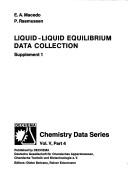| Listing 1 - 10 of 496 | << page >> |
Sort by
|
Book
ISBN: 2100497006 Year: 2006 Publisher: Paris : Dunod : L'Usine nouvelle,
Abstract | Keywords | Export | Availability | Bookmark
 Loading...
Loading...Choose an application
- Reference Manager
- EndNote
- RefWorks (Direct export to RefWorks)
Mixtures --- Mélange. --- Mélanges (chimie) --- Mixtures.
Book
Year: 1973 Publisher: [S.l.]: [chez l'auteur],
Abstract | Keywords | Export | Availability | Bookmark
Book
ISBN: 392156719X Year: 1980 Publisher: Frankfurt am Main : Dechema,
Abstract | Keywords | Export | Availability | Bookmark
 Loading...
Loading...Choose an application
- Reference Manager
- EndNote
- RefWorks (Direct export to RefWorks)
Book
ISBN: 3489760220 Year: 1962 Publisher: Berlin Paul Parey
Abstract | Keywords | Export | Availability | Bookmark
 Loading...
Loading...Choose an application
- Reference Manager
- EndNote
- RefWorks (Direct export to RefWorks)
horticulture --- peat --- soil mixtures
Book
ISBN: 3110452243 311045226X 9783110452266 9783110452242 3110452170 Year: 2016 Publisher: Berlin : De Gruyter,
Abstract | Keywords | Export | Availability | Bookmark
 Loading...
Loading...Choose an application
- Reference Manager
- EndNote
- RefWorks (Direct export to RefWorks)
Chapter 1 General IntroductionDefinition of emulsions and the role of the emulsifier. Classification based on the nature of the emulsifier. Classification based on the structure of the system. General instability problems with emulsions : creaming/sedimentation, flocculation, Ostwald ripening, coalescence and phase inversion. Importance of emulsions in various industrial applications. Chapter 2 Thermodynamics of Emulsion Formation and BreakdownApplication of the second law of thermodynamics for emulsion formation : Balance of energy and entropy and non-spontaneous formation of emulsions. Breakdown of the emulsion by flocculation and coalescence in the absence of an emulsifier. Role of the emulsifier in preventing flocculation and coalescence by creating an energy barrier resulting from the repulsive energies between the droplets. Chapter 3 Interaction Forces between Emulsion DropletsVan der Waals attraction and its dependence on droplet size, Hamaker constant and separation distance between the droplets. Electrostatic repulsion resulting from the presence of electrical double layers and its dependence on surface (or zeta) potential and electrolyte concentration and valency. Combination of the van der Waals attraction with double layer repulsion and the theory of colloid stability. Steric repulsion resulting from the presence of adsorbed non-ionic surfactants and polymers. Combination of van der Waals attraction with steric repulsion and the theory of steric stabilisation. Chapter 4 Adsorption of Surfactants at the Oil/Water InterfaceThermodynamic analysis of surfactant adsorption and the Gibbs adsorption isotherm. Calculation of the amount of surfactant adsorption and area per surfactant molecule at the interface. Experimental techniques for measuring the interfacial tension. Chapter 5 Mechanism of Emulsification and the Role of the EmulsifierDescription of the factors responsible for droplet deformation and its break-up. Role of surfactant in preventing coalescence during emulsification. Definition of the Gibbs dilational elasticity and the Marangoni effect in preventing coalescence. Chapter 6 Methods of EmulsificationPipe flow, static mixers and high speed stirrers (rotor-stator mixer). Laminar and turbulent flow. Membrane emulsification. High pressure homogenisers and ultrasonic methods. Chapter 7 Selection of EmulsifiersThe hydrophilic-lipophilic-balance (HLB) and its application in surfactant selection. Calculation of HLB numbers and the effect of the nature of the oil phase. The phase inversion temperature (PIT) method for emulsifier selection. The cohesive energy ratio method for emulsifier selection. Chapter 8 Creaming/Sedimentation of Emulsions and its preventionDriving force for creaming/sedimentation: effect of gravity, droplet size and density difference between the oil and continuous phase. Calculation of the rate of creaming/sedimentation in dilute emulsions. Influence of increase of the volume fraction of the disperse phase on the rate of creaming/sedimentation. Reduction of creaming/sedimentation: Balance of the density of the two phases, reduction of droplet size and effect of addition of ''thickeners'. Chapter 9 Flocculation of Emulsions and its PreventionFactors affecting flocculation. Calculation of fast and slow flocculation rate. Definition of stability ratio and its dependence on electrolyte concentration and valency. Definition of the critical coagulation concentration and its dependence on electrolyte valency. Reduction of flocculation by enhancing the repulsive forces. Chapter 10 Ostwald Ripening and its ReductionFactors responsible for Ostwald ripening : difference in solubility between small and large droplets and the Kelvin equation. Calculation of the rate of Ostwald ripening. Reduction of Ostwald ripening by incorporation of a small amount of highly insoluble oil. Reduction of Ostwald ripening by the use of strongly adsorbed polymeric surfactant and enhancement of the Gibbs elasticity. Chapter 11 Emulsion Coalescence and its PreventionDriving force for emulsion coalescence : Thinning and disruption of the liquid film between the droplets. The concept of disjoining pressure for prevention of coalescence. Methods for reduction or elimination of coalescence : Use of mixed surfactant films, use of lamellar liquid crystalline phases and use of polymeric surfactants. Chapter 12 Phase Inversion and its PreventionDistinction between catastrophic and transient phase inversion. Influence of the disperse volume fraction and surfactant HLB number. Explanation of the factors responsible for phase inversion. Chapter 13 Characterisation of EmulsionsMeasurement of droplet size distribution : Optical microscopy and image analysis. Phase contrast and polarising microscopyDiffraction methods. Confocal laser microscopy. Back scattering methods Chapter 14 Industrial Application of Emulsions14.1 Application in Pharmacy14.2 Application in Cosmetics 14.3 Application in Agrochemicals14.4 Application in Paints14.5 Application in the Oil Industry

ISBN: 9780120884995 0120884992 9780080472652 0080472656 9786610968220 1280968222 Year: 2004 Publisher: Amsterdam : Academic Press,
Abstract | Keywords | Export | Availability | Bookmark
 Loading...
Loading...Choose an application
- Reference Manager
- EndNote
- RefWorks (Direct export to RefWorks)
Emulsion science is rapidly developing due to its practical importance and the fundamental challenges that it offers. Due to its complexity, there is still a significant lack of understanding about emulsions. With its comprehensive and rigorous approach, Emulsions: Structure, Stability and Interactions is the perfect 'stand-alone' source of information for scientists looking to obtain up-to-date knowledge about the fundamentals of emulsion science and those looking to familiarize themselves with the subject in greater detail. While each chapter presents a concise review on a specific topic, th
Book
Year: 1985 Publisher: Louvain-la-Neuve: [éditeur inconnu],
Abstract | Keywords | Export | Availability | Bookmark
 Loading...
Loading...Choose an application
- Reference Manager
- EndNote
- RefWorks (Direct export to RefWorks)

ISBN: 9789004480209 9789041119513 Year: 2002 Publisher: Leiden; Boston : Brill | Nijhoff
Abstract | Keywords | Export | Availability | Bookmark
 Loading...
Loading...Choose an application
- Reference Manager
- EndNote
- RefWorks (Direct export to RefWorks)
The introduction of a market economy in the countries of Central and Eastern Europe required an enormous legislative effort, in order to create the regulatory framework for a vast array of new economic activities. The resulting statutory materials in turn gave rise to numerous books and articles, by domestic lawyers from the countries concerned, as well as by foreign scholars. By comparison, the other part of the legal diptych - the establishment of the rule of law - has received less attention from academic commentators. The purpose of this volume is to correct the balance to some extent, especially by looking at various aspects of legal reform through the prism of human rights. The legal implementation of a respect for human rights turns out to be an even more comprehensive and pervasive enterprise than creating the legal framework for a market economy. A number of important areas of law are highlighted in this volume; the emphasis is, although not exclusively, on the Russian Federation.
Human rights --- Mixtures

ISBN: 3921567734 Year: 1987 Publisher: Frankfurt am Main : Dechema,
Abstract | Keywords | Export | Availability | Bookmark
 Loading...
Loading...Choose an application
- Reference Manager
- EndNote
- RefWorks (Direct export to RefWorks)
Liquid-liquid equilibrium --- Multicomponent mixtures --- Ternary mixtures --- Liquid-liquid equilibrium --- Multicomponent mixtures --- Ternary mixtures
Book
Year: 1969 Publisher: New York, NY : Consultants Bureau,
Abstract | Keywords | Export | Availability | Bookmark
 Loading...
Loading...Choose an application
- Reference Manager
- EndNote
- RefWorks (Direct export to RefWorks)
PHYSICAL CHEMISTRY --- CRISTALLISATION --- SOLUTIONS (MIXTURES) --- PHYSICAL CHEMISTRY --- CRISTALLISATION --- SOLUTIONS (MIXTURES)
| Listing 1 - 10 of 496 | << page >> |
Sort by
|

 Search
Search Feedback
Feedback About
About Help
Help News
News